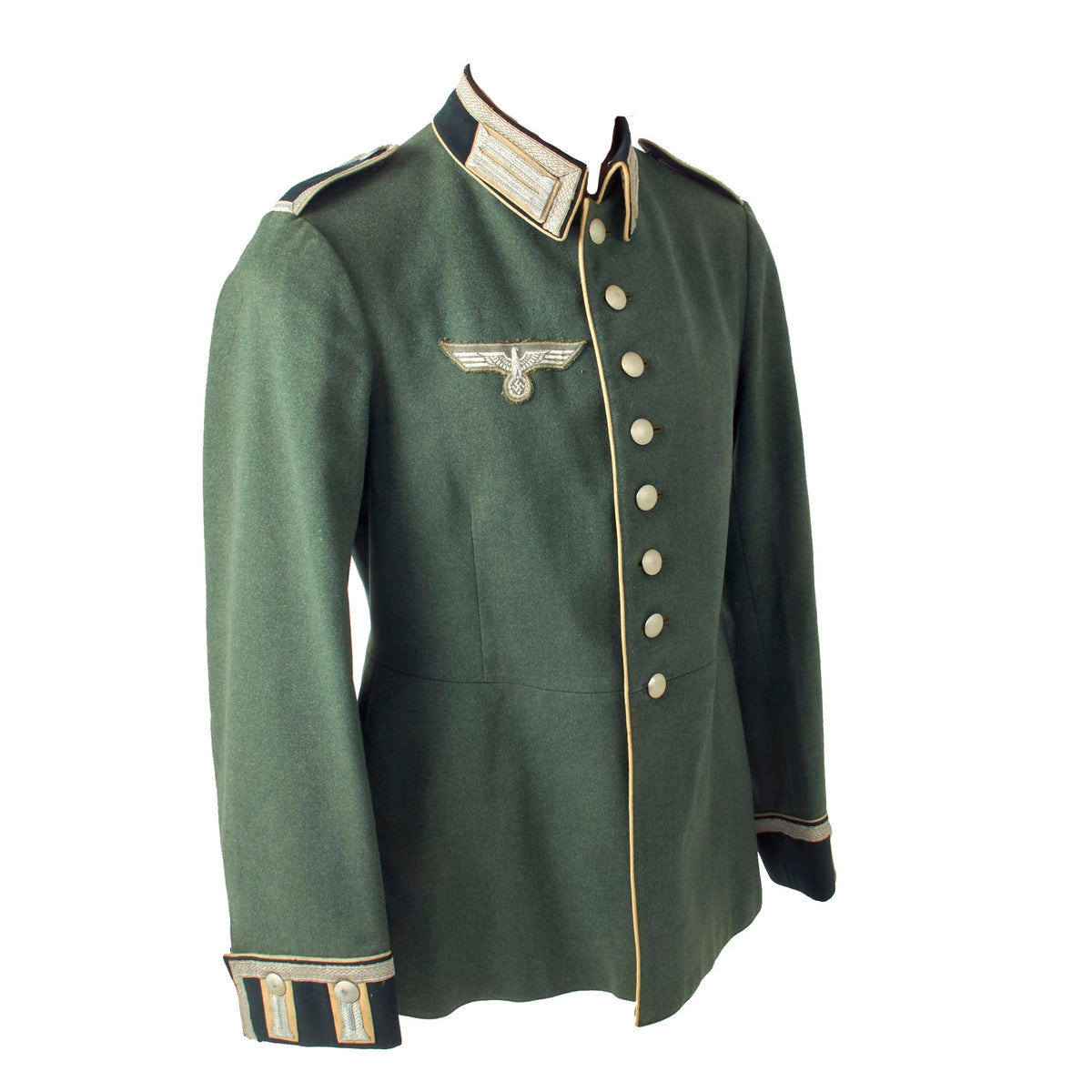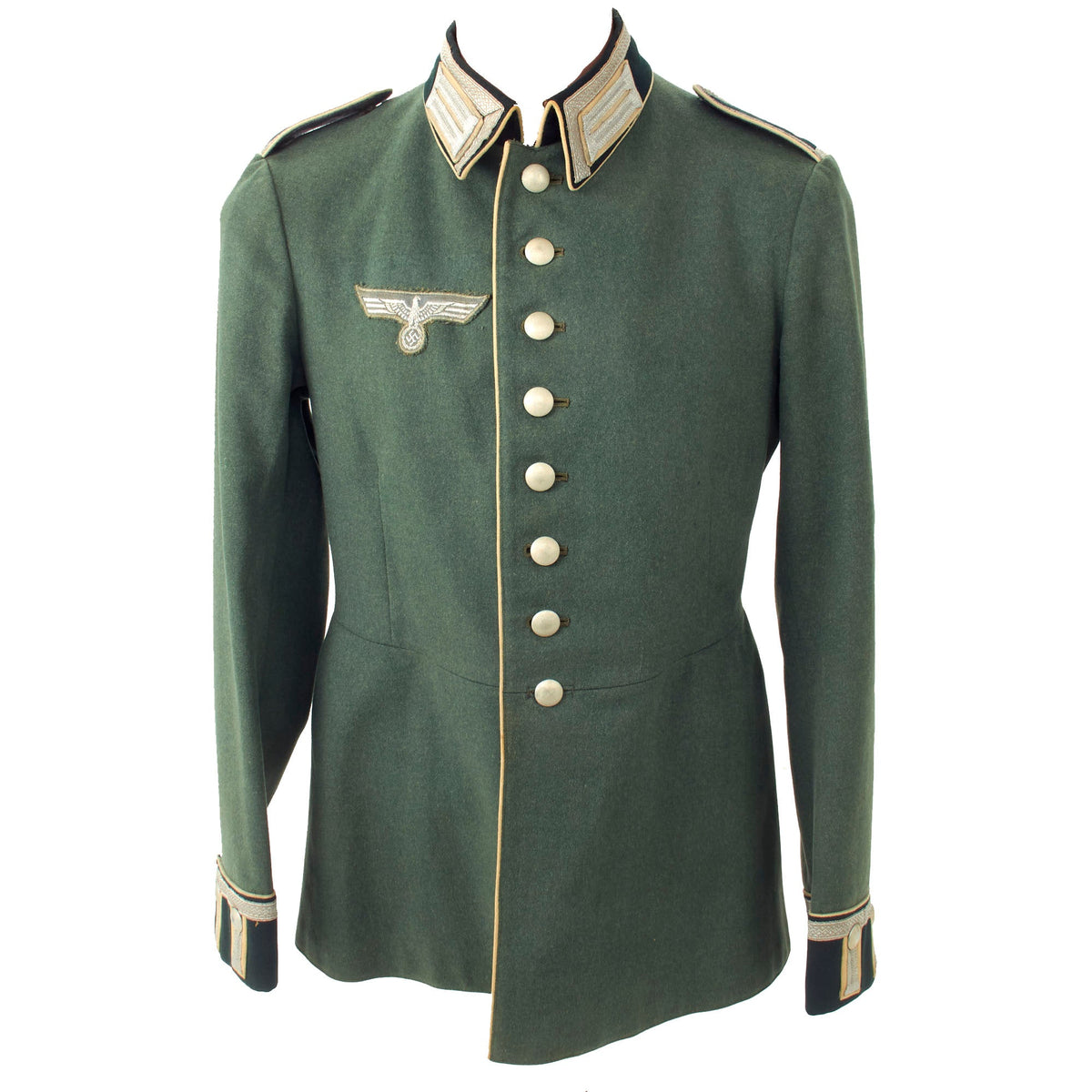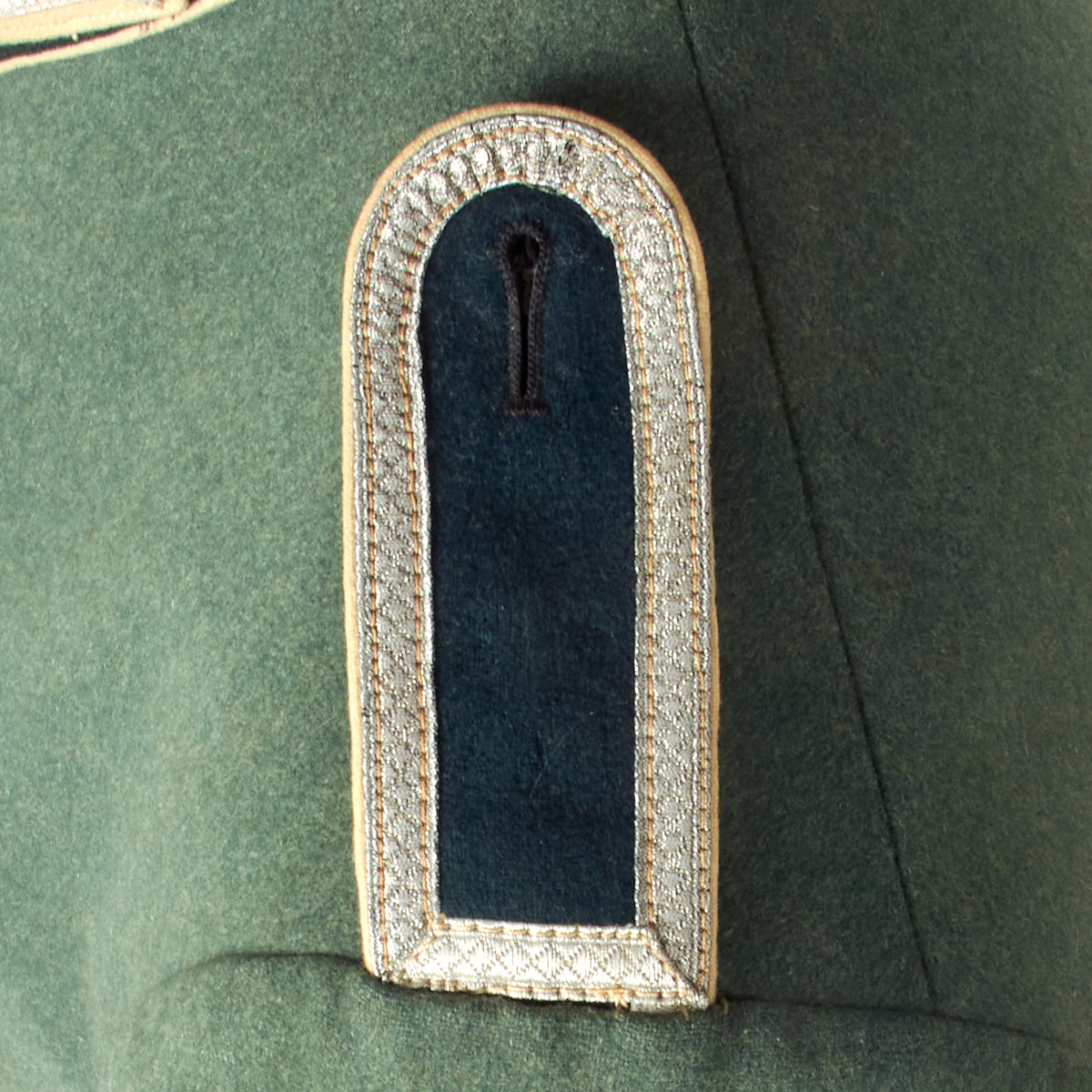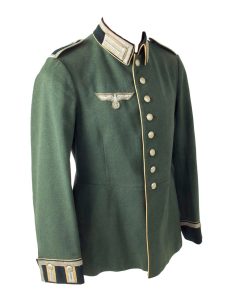Original German WWII Heer Army Unterfeldwebel NCO M35 Waffenrock Dress Tunic – dated 1938 Original Items
$ 850,00 $ 212,50
Original Item: Only One Available. This is a very nice service used Heer Infantry Unteroffiziere ohne Portepee (Junior NCO) M35 Waffenrock Dress Tunic. The base material of the uniform is made of a fine feldgrau colored wool. The wool shows no signs of any physical damage by misuse but does display light wear, staining and a bit of mothing. The collar is wrapped in a dark-green wool, decorated a strip of 14mm flat silver-grey woven rayon braid (Unteroffoziers-Tressen), sewn around the collar border. The base material of the two dress litzen on each side of the collar opening is Weiß (white), which was the Waffenfarbe (corps color) during WWII for infantry and motorized infantry. The collar, front closure, and other areas of the tunic bear piping of the same color. The two litzen themselves are woven from a fine silver flatware thread. The collar does show wear, and the tresse is detached along alot of the top edge due to the stitching having popped.
The “sew-in” style NCO schulterklappen (shoulder straps) of this Waffenrock have a dark green base wool, with the correct NCO Tresse sewn around the entire edge, and are piped in white. The right side button is still present, but the left side button has fallen off. There are no rank “pips” installed, indicating the NCO rank of Unterfeldwebel, equivalent to a U.S. Army Staff Sergeant. There are some holes in the straps, indicating that there was a unit number sewn in on both at one time. The front breast eagle is a correct NCO Pattern machine executed in silver wire, hand stitched to the exterior. Condition is excellent, with no fraying or oxidation that we can see.
Eight silvered buttons adorn the front of the tunic and all appear to be originally attached, and the collar still retains the two hook and loop fasteners. The buttons are mostly maker marked, and those on the front are marked MOTZ. The lower French style cuffs of the sleeves have a dark-green based wool, and are adorned with white piping and NCO Tress flat silver borders. The sleeve litzen are the correct silver on white for infantry.
The interior is lined with a very nice olive colored cotton rayon blend, with a pocket on the left interior, as is standard. It has size markings on the left inside over the pocket, which look to read:
98 43
42 — —
88 64
B 38
These markings indicate that this overcoat was issued at the Berlin Depot in 1938. The size markings most likely indicate the following:
Chest: 98cm = 38.6 in.
Neck: 43cm = 16.9 in.
Torso Length: 42cm = 16.5 in.
Total Length: 88cm = 34.6 in.
Sleeve Length: 64cm = 25.2 in.
This closely matches the measurements we took ourselves, listed below.
This is a very nice Infantry Unterfeldwebel NCO Waffenrock, ready to outfit with some awards and display!
Approx. Measurements:
Collar to shoulder: 9″
Shoulder to sleeve: 25”
Shoulder to shoulder: 15”
Chest width: 18″
Waist width: 17″
Hip width: 22”
Front length: 30.5″
The M35 Waffenrock dress tunic was introduced for wear by all ranks on June 29TH 1935 as the walking out, parade and ceremonial dress with the piped, stone grey long pants. The design of the M35 dress tunic was based on the Imperial German army’s service tunic but was a different color and generally of much higher quality. Originally all personnel were issued two M35 dress tunics but manufacture was discontinued in late 1939 or early 1940 and was to be reinstated at the successful conclusion of the war. Regulations of March 21ST 1940 stated that the M35 dress tunics that were no longer suitable for dress wear were to be modified and reissued to personnel of the replacement and reserve units for every day wear. Officers and certain senior NCO ranks were responsible for purchasing their own uniforms and as a result were allotted a clothing allowance through the army’s Kleiderkasse, (Clothing Account), system. The Officers and certain senior NCO’s could choose to purchase their uniforms from the armed forces clothing depots or to privately purchase garments of higher quality. Although enlisted personnel were issued their uniforms from government supplies they were also permitted to purchase privately tailored uniforms although the price may have been restrictive.
Fast Shipping with Professional Packaging
Thanks to our longstanding association with UPS FedEx DHL, and other major international carriers, we are able to provide a range of shipping options. Our warehouse staff is expertly trained and will wrap your products according to our exact and precise specifications. Prior to shipping, your goods will be thoroughly examined and securely secured. We ship to thousands clients each day across multiple countries. This shows how we're dedicated to be the largest retailer on the internet. Warehouses and distribution centres can be located throughout Europe as well as the USA.
Note: Orders with more than one item will be assigned a processing date depending on the item.
Before shipping before shipping, we'll conduct a thorough inspection of the items you have ordered. Today, the majority of orders will be delivered within 48 hours. The delivery time will be between 3-7 days.
Returns
The stock is dynamic and we cannot completely manage it because multiple stakeholders are involved, including our factory and warehouse. So the actual stock may alter at any time. It's possible that you may not receive your order once the order has been made.
Our policy is valid for a period of 30 days. If you don't receive the product within 30 days, we are not able to issue a refund or an exchange.
You can only return an item if it is unused and in the same state as the day you received it. You must have the item in its original packaging.
Related products
Uncategorized
Uncategorized
Uncategorized
Uncategorized
Uncategorized
Uncategorized
Uncategorized
Australian WWII Owen MK1 Machine Carbine SMG Custom Fabricated Replica with Sling Original Items
Uncategorized
Uncategorized
Uncategorized
Band of Brothers ORIGINAL GERMAN WWII Le. F.H. 18 10.5cm ARTILLERY PIECE Original Items
Uncategorized
Uncategorized
Uncategorized
Uncategorized
Uncategorized
Uncategorized
Uncategorized
Armoured Fighting Vehicles of the World: AFVs of World War One (Hardcover Book) New Made Items
Uncategorized
Armored Burgonet Helmet & Polearm from Scottish Castle Leith Hall Circa 1700 Original Items
Uncategorized












































































